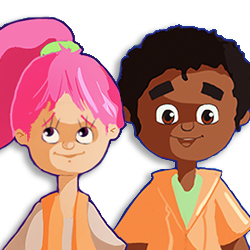Cyber Choices - Description
 Cyber Choices is designed to help students in grades 3 to 5 develop the skills and habits they need to make safe and responsible choices online. Delivered in an engaging online comic-book format (with accompanying audio to support developing readers), Cyber Choices lets students explore four different stories that cover key issues such as making good choices about your own and others’ personal information, dealing with cyberbullying (as both a target and a witness) and managing online conflict.
Cyber Choices is designed to help students in grades 3 to 5 develop the skills and habits they need to make safe and responsible choices online. Delivered in an engaging online comic-book format (with accompanying audio to support developing readers), Cyber Choices lets students explore four different stories that cover key issues such as making good choices about your own and others’ personal information, dealing with cyberbullying (as both a target and a witness) and managing online conflict.
At key moments, students practice their decision-making skills by sorting out the reasons why the character might make one choice rather than another before deciding which way the story will go. Once students have played each story to one of the different possible conclusions, the game prompts students to feel empathy in digital environments by asking them to reflect on how the different people in the story felt about how the story turned out. In a classroom setting, the multiple endings for each story can lead to meaningful classroom discussions after playing.
Cyber Choices is designed to teach and foster the following skills and qualities:
Confidence and efficacy online. Cyber Choices helps students to become active online citizens by showing them that what they do online matters and has an effect on their own and others’ lives. Self-efficacy – believing that you know what to do in different situations and that what you do makes a difference – has been found to be a key factor in protecting youth from online risks, reducing the harm done when things go wrong, and prompting them to do something when they witness online bullying.
Ethical thinking. One of the key steps in making an ethical decision is identifying the situation as a moral issue, so it’s essential that young people be taught to view the online world through an ethical lens. Cyber Choices promotes students’ ethical thinking by showing how the characters’ online and offline worlds are connected: what the characters do in one may have consequences in the other.
Empathy. While empathy has many elements, one important part is imagining what someone else is thinking or feeling – which has been shown to be a skill that improves with practice. Cyber Choices promotes empathy by encouraging students to imagine how each of the characters feels about the situation they are in, and to reconsider their assumptions by showing them an online conflict from three different perspectives – the target, a witness and the perpetrator. At the end of each story students are asked how they think the characters felt about what happened and are given feedback on their choice.
Emotional regulation. MediaSmarts’ research suggests that a lot of online aggression happens when kids want to get back at someone they feel has done something bad to them or to their friends. To avoid and defuse conflict online, students need to be able to identify and manage their emotions, two of the key elements of social-emotional learning. Cyber Choices teaches kids ways to deal with their own and others’ feelings, including concrete steps they can take such as not responding to others when they’re feeling anger or other “hot” emotions, talking out conflicts in person rather than online, and stepping away from online conflict until they’ve cooled down.
Resiliency. Because it’s impossible to totally avoid negative experiences online, Cyber Choices helps students develop coping strategies that have been shown to work in reducing the impact of cyberbullying and other online risks. As well as modeling ways of dealing with specific online issues, the game encourages broader habits that contribute to resiliency. In particular, students are shown how to fix their mistakes by making sure “bad” choices are always followed by opportunities to make things better. It also helps students to find different solutions to a problem by giving them a chance to re-play each story as many times as they like and encourages them to seek help from peers, teachers and family members.
